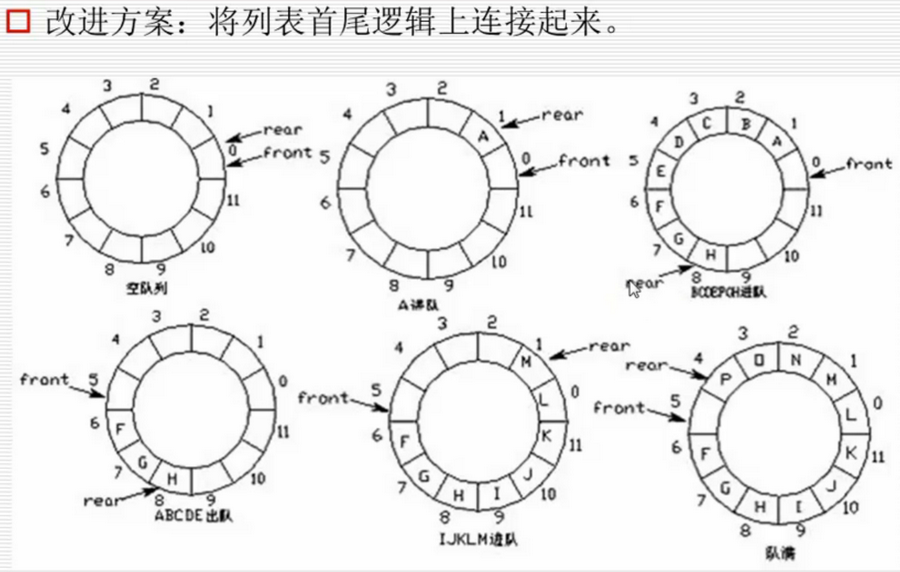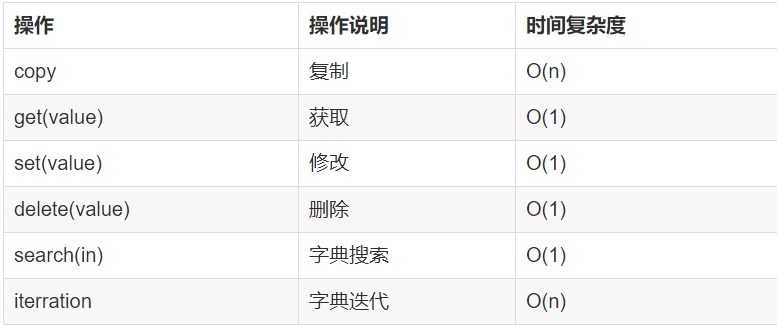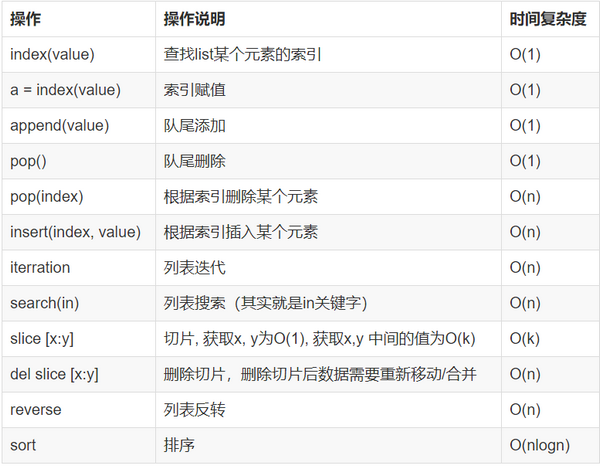算法其他篇
目录:
- 1.1 数据结构中的一些概念
- 1.2 栈(stack)
- 1.3 队列
- 1.4 链表
- 1.5 python中字典对象实现原理
- 1.6 数组
1.1 数据结构中的一些概念 返回顶部
1、数据结构是什么
1、简单来说,数据结果就是设计数据以何种方式存储在计算机中
2、比如:列表,集合,与字典等都是一种数据结构
3、程序 = 数据结构 + 算法
1.2 栈(stack) 返回顶部
1、栈的定义
栈是一种数据集合,可以理解为只能在一端进行插入或删除操作的列表
2、栈的特点
后进先出(last-in, first-out)
3、栈的概念
栈顶,栈底
4、栈的基本操作
进栈(压栈):push
出栈:pop
取栈顶:gettop
5、栈的使用:匹配括号是否成对出现


def check_kuohao(s):stack = []for char in s:if char in ['(','[','{']:stack.append(char)elif char == ')':if len(stack)>0 and stack[-1] == '(':stack.pop()else:return Falseelif char == ']':if len(stack) > 0 and stack[-1] == '[':stack.pop()else:return Falseelif char == '}':if len(stack) > 0 and stack[-1] == '{':stack.pop()else:return Falseif len(stack) == 0:return Trueelse:return False print(check_kuohao('(){}{}[]')) #True
1.3 队列 返回顶部
1、队列定义
1、队列是一个数据集合,仅允许在列表的一端进行插入,另一端进行删除
2、插入的一端称为队尾(rear),插入动作叫进队或入队
3、进行删除的一端称为对头(front),删除动作称为出队
4、队列性质:先进先出(First-in, First-out)
5、双向队列:队列的两端都允许进行进队和出队操作
2、对列使用方法
1、导入: from collectios import deque
2、创建队列:queue = deque(li)
3、进队: append
4、出队: popleft
5、双向队列队首进队:appendleft
6、双向队列队尾出队:pop
3、双向对列原理图
1、 环形对列:当对位指针front == Maxsize + 1 时,再进一个位置就自动到0
2、 实现方法:求余数运算
3、 队首指针前进1: front = (front + 1)%MaxSize
4、 队尾指针前进1:rear = (rear+1)%MaxSize
5、 队空条件:rear == front
6、 队满条件:(rear+1)%MaxSize == front

1.4 链表 返回顶部
1、单链表
注:链表中每个元素都是一个对象,每个对象称为一个节点,包含有数据域key和指向下一节点的指针next,通过各个节点间的相互连接,最终串联成一个链表



#! /usr/bin/env python # -*- coding: utf-8 -*- class Node(object):def __init__(self, item):self.item = itemself.next = Noneclass DLinkList(object):def __init__(self):self._head = Nonedef is_empty(self):return self._head == Nonedef append(self, item):'''尾部追加元素'''node = Node(item)if self.is_empty():self._head = nodeelse:cur = self._headwhile cur.next != None:cur = cur.nextcur.next = nodedef add(self, item):"""头部插入元素"""node = Node(item)if self.is_empty():self._head = node # 如果是空链表,将_head指向nodeelse:node.next = self._head # 将node的next指向_head的头节点self._head = node # 将_head 指向nodedef travel(self):cur = self._headwhile cur != None:print cur.item,cur = cur.nextprint ""def remove(self, item):"""删除元素"""if self.is_empty():returnelse:cur = self._headif cur.item == item:# 如果首节点的元素即是要删除的元素if cur.next == None: # 如果链表只有这一个节点self._head = Noneelse: # 将_head指向第二个节点self._head = cur.nextreturnwhile cur != None:if cur.next.item == item:cur.next = cur.next.nextbreakcur = cur.nextdef insert(self, pos, item):"""在指定位置添加节点"""if pos <= 0:self.add(item)elif pos > (self.length() - 1):self.append(item)else:node = Node(item)cur = self._headcount = 0# 移动到指定位置的前一个位置while count < (pos - 1):count += 1cur_next = cur.next# 将node的next指向cur的下一个节点cur.next = nodenode.next = cur_nextdef length(self):"""返回链表的长度"""cur = self._headcount = 0while cur != None:count += 1cur = cur.nextreturn countif __name__ == '__main__':ll = DLinkList()# 1、将链表后面追加三个元素:1,2,3ll.append(1)ll.append(2)ll.append(3)ll.travel() # 1 2 3# 2、将链表头部插入一个元素:0 ll.add(0)ll.travel() # 1 2 3 ==> 0 1 2 3# 3、删除链表中的元素:3ll.remove(3)ll.travel() # 0 1 2 3 ==> 0 1 2# 4、在链表的第2号位置插入元素:8ll.insert(2,8)ll.travel() # 0 1 2 ==> 0 8 1 2


#! /usr/bin/env python # -*- coding: utf-8 -*- class Node(object):def __init__(self, val):self.val = valself.next = Nonedef list_reverse(head):if head == None:return NoneL, R, cur = None, None, head # 左指针、有指针、游标while cur.next != None:L = R # 左侧指针指向以前右侧指针位置R = cur # 右侧指针前进一位指向当前游标位置cur = cur.next # 游标每次向前进一位R.next = L # 右侧指针指向左侧实现反转cur.next = R # 当跳出 while 循环时 cur(原链表最后一个元素) R(原链表倒数第二个元素)return curif __name__ == '__main__':'''原始链表:1 -> 2 -> 3 -> 4反转链表:4 -> 3 -> 2 -> 1'''l1 = Node(1)l1.next = Node(2)l1.next.next = Node(3)l1.next.next.next = Node(4)l = list_reverse(l1)print l.val # 4 反转后链表第一个值4print l.next.val # 3 第二个值3


#! /usr/bin/env python # -*- coding: utf-8 -*- class ListNode(object):def __init__(self, val, next=None):self.val = valself.next = next# 归并法: 对链表排序 class Solution:def sortList(self, head):if head is None or head.next is None:return headpre = headslow = head # 使用快慢指针来确定中点fast = headwhile fast and fast.next:pre = slowslow = slow.nextfast = fast.next.nextleft = headright = pre.nextpre.next = None # 从中间打断链表left = self.sortList(left)right = self.sortList(right)return self.merge(left, right)def merge(self, left, right):pre = ListNode(-1)first = prewhile left and right:if left.val < right.val:pre.next = leftpre = leftleft = left.nextelse:pre.next = rightpre = rightright = right.nextif left:pre.next = leftelse:pre.next = rightreturn first.nextnode1 = ListNode(4) node2 = ListNode(3) node3 = ListNode(2) node4 = ListNode(1)node1.next = node2 node2.next = node3 node3.next = node4s = Solution() result = s.sortList(node1)while (result != None):print result.val, # 1 2 3 4result = result.next


#!/usr/bin/env python # -*- coding:utf-8 -*- def mergesort(seq):if len(seq) <= 1:return seqmid = int(len(seq) / 2)left = mergesort(seq[:mid])right = mergesort(seq[mid:])return merge(left, right)def merge(left, right):result = []i, j = 0, 0while i < len(left) and j < len(right):if left[i] <= right[j]:result.append(left[i])i += 1else:result.append(right[j])j += 1result += left[i:]result += right[j:]return resultif __name__ == '__main__':seq = [10,4,6,3,8,2,5,7]print mergesort(seq) # [2, 3, 4, 5, 6, 7, 8, 10]
2、双链表
注:双链表中每个节点有两个指针:一个指针指向后面节点、一个指向前面节点



#! /usr/bin/env python # -*- coding: utf-8 -*- class Node(object):"""双向链表节点"""def __init__(self, item):self.item = itemself.next = Noneself.prev = Noneclass DLinkList(object):"""双向链表"""def __init__(self):self._head = Nonedef is_empty(self):"""判断链表是否为空"""return self._head == Nonedef length(self):"""返回链表的长度"""cur = self._headcount = 0while cur != None:count += 1cur = cur.nextreturn countdef travel(self):"""遍历链表"""cur = self._headwhile cur != None:print cur.item,cur = cur.nextprint ""def add(self, item):"""头部插入元素"""node = Node(item)if self.is_empty():# 如果是空链表,将_head指向nodeself._head = nodeelse:# 将node的next指向_head的头节点node.next = self._head# 将_head的头节点的prev指向nodeself._head.prev = node# 将_head 指向nodeself._head = nodedef append(self, item):"""尾部插入元素"""node = Node(item)if self.is_empty():# 如果是空链表,将_head指向nodeself._head = nodeelse:# 移动到链表尾部cur = self._headwhile cur.next != None:cur = cur.next# 将尾节点cur的next指向nodecur.next = node# 将node的prev指向curnode.prev = curdef search(self, item):"""查找元素是否存在"""cur = self._headwhile cur != None:if cur.item == item:return Truecur = cur.nextreturn Falsedef insert(self, pos, item):"""在指定位置添加节点"""if pos <= 0:self.add(item)elif pos > (self.length() - 1):self.append(item)else:node = Node(item)cur = self._headcount = 0# 移动到指定位置的前一个位置while count < (pos - 1):count += 1cur = cur.next# 将node的prev指向curnode.prev = cur# 将node的next指向cur的下一个节点node.next = cur.next# 将cur的下一个节点的prev指向nodecur.next.prev = node# 将cur的next指向nodecur.next = nodedef remove(self, item):"""删除元素"""if self.is_empty():returnelse:cur = self._headif cur.item == item:# 如果首节点的元素即是要删除的元素if cur.next == None:# 如果链表只有这一个节点self._head = Noneelse:# 将第二个节点的prev设置为Nonecur.next.prev = None# 将_head指向第二个节点self._head = cur.nextreturnwhile cur != None:if cur.item == item:# 将cur的前一个节点的next指向cur的后一个节点cur.prev.next = cur.next# 将cur的后一个节点的prev指向cur的前一个节点cur.next.prev = cur.prevbreakcur = cur.nextif __name__ == "__main__":ll = DLinkList()ll.add(1)ll.add(2)# ll.append(3)# ll.insert(2, 4)# ll.insert(4, 5)# ll.insert(0, 6)# print "length:",ll.length()# ll.travel()# print ll.search(3)# print ll.search(4)# ll.remove(1)print "length:",ll.length()ll.travel()


#! /usr/bin/env python # -*- coding: utf-8 -*- class Node(object):def __init__(self, item):self.item = itemself.next = Noneself.prev = Noneclass DLinkList(object):def __init__(self):self._head = Nonedef is_empty(self):return self._head == Nonedef append(self, item):node = Node(item)if self.is_empty():self._head = nodeelse:cur = self._headwhile cur.next != None:cur = cur.nextcur.next = nodenode.prev = curdef travel(self):cur = self._headwhile cur != None:print cur.item,cur = cur.nextif __name__ == '__main__':ll = DLinkList()ll.append(1)ll.append(2)ll.append(3)# print ll._head.item # 打印第一个元素:1# print ll._head.next.item # 打印第二个元素:2# print ll._head.next.next.item # 打印第三个元素:3ll.travel() # 1 2 3
1.5 python中字典对象实现原理 返回顶部
注:字典类型是Python中最常用的数据类型之一,它是一个键值对的集合,字典通过键来索引,关联到相对的值,理论上它的查询复杂度是 O(1)
1、哈希表 (hash tables)
1. 哈希表(也叫散列表),根据关键值对(Key-value)而直接进行访问的数据结构。
2. 它通过把key和value映射到表中一个位置来访问记录,这种查询速度非常快,更新也快。
3. 而这个映射函数叫做哈希函数,存放值的数组叫做哈希表。
4. 通过把每个对象的关键字k作为自变量,通过一个哈希函数h(k),将k映射到下标h(k)处,并将此对象存储在这个位置。
2、具体操作过程
1. 数据添加:把key通过哈希函数转换成一个整型数字,然后就将该数字对数组长度进行取余,取余结果就当作数组的下标,
将value存储在以该数字为下标的数组空间里。
2. 数据查询:再次使用哈希函数将key转换为对应的数组下标,并定位到数组的位置获取value。
3、{“name”:”zhangsan”,”age”:26} 字典如何存储的呢?
1. 比如字典{“name”:”zhangsan”,”age”:26},那么他们的字典key为name、age,假如哈希函数h(“name”) = 1、h(“age”)=3,
2. 那么对应字典的key就会存储在列表对应下标的位置,[None, “zhangsan”, None, 26 ]
4、解决hash冲突

5、python字典操作时间复杂度

1.6 数组 返回顶部
1、数组定义
1. 所谓数组,就是相同数据类型的元素按一定顺序排列的集合
2. 在Java等其他语言中并不是所有的数据都能存储到数组中,只有相同类型的数据才可以一起存储到数组中。
3. 因为数组在存储数据时是按顺序存储的,存储数据的内存也是连续的,所以他的特点就是寻址读取数据比较容易,插入和删除比较困难。
2、python中list与数组比较
1. python中的list是python的内置数据类型,list中的数据类不必相同的,而array的中的类型必须全部相同。
2. 在list中的数据类型保存的是数据的存放的地址,简单的说就是指针,并非数据
3. 这样保存一个list就太麻烦了,例如list1=[1,2,3,'a']需要4个指针和四个数据,增加了存储和消耗cpu。
















![[面经]春季跳槽面筋总结 [2018年3月17]](http://pic.xiahunao.cn/[面经]春季跳槽面筋总结 [2018年3月17])
)


)